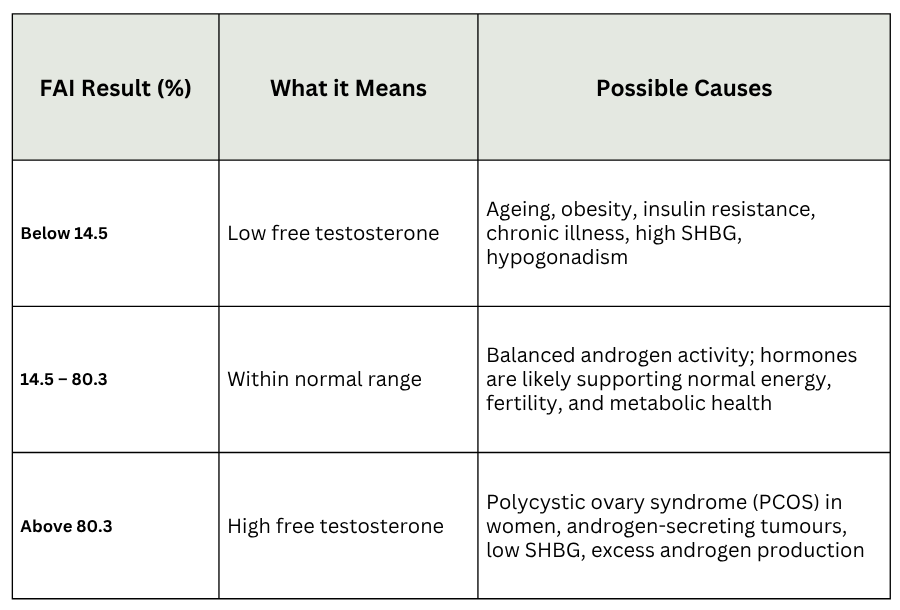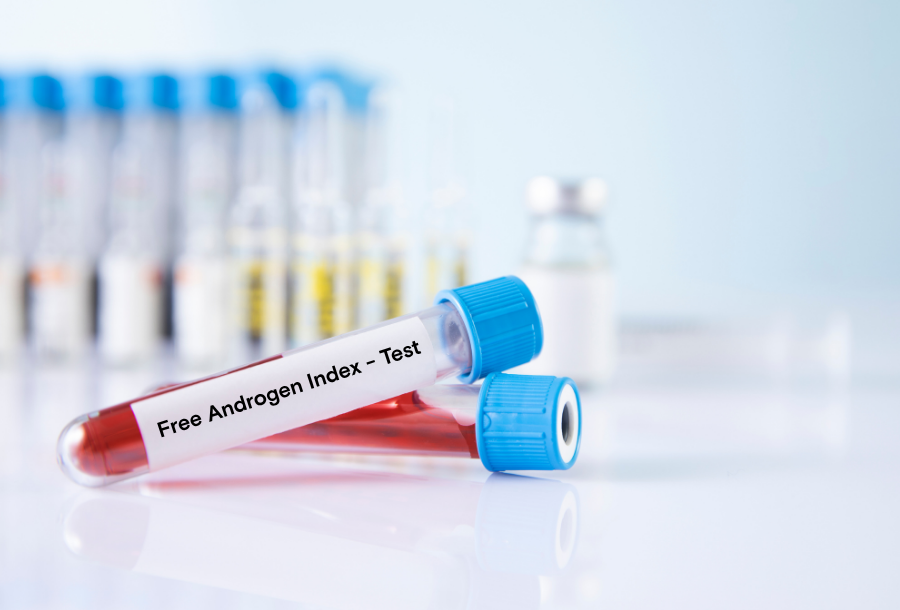Black Friday Sale on Now: $100 Off Everything | Up to $500 in Savings when you bundle
Choose how you’d like to begin
CGM program
Optimise metabolism in real time with sensors

Advanced Blood Test
Get your baseline health report and personalised plan




The Free Androgen Index (FAI) blood test is a calculation that measures the balance between total testosterone and sex hormone-binding globulin (SHBG) in the blood. It provides an estimate of how much free, active testosterone is available for the body to use.
This test is particularly important in assessing conditions related to hormone imbalance, including polycystic ovary syndrome (PCOS) in women, low testosterone in men, and metabolic or reproductive health concerns. By understanding your FAI levels, doctors can gain insights into hormonal health, energy levels, fertility, and overall wellbeing.
This guide explains what it is, how it works, what your results mean, and how you can book a comprehensive blood test to check your Free Androgen Index (FAI).
The Free Androgen Index (FAI) is a calculation that shows how much active testosterone is available in your body. Testosterone in the blood exists in two forms: bound (attached to proteins like SHBG) and free (ready for the body to use). FAI compares total testosterone with SHBG to estimate the amount of free testosterone.
A simple way to picture this is like money in your bank account. Most of it might be “locked” in a savings account (bound testosterone), while only a smaller portion is “spending money” you can use right away (free testosterone). The FAI tells you how much of that usable energy you really have.
Quick facts:
Knowing your FAI helps assess hormone balance, metabolic health, and overall wellbeing. It’s often tested when symptoms like fatigue, irregular periods, fertility issues, or changes in weight or mood appear.
The Free Androgen Index (FAI) offers a window into your hormonal balance, metabolic health, and long-term vitality. Since free testosterone is the “active” form that influences tissues (while most testosterone is bound and inactive), FAI helps estimate how much of your androgen is actually usable. In doing so, it links directly to energy levels, body composition, insulin sensitivity, and even aging.
When FAI is too low, it can contribute to fatigue, loss of muscle, poor libido, and increased risk of weight gain or osteoporosis. In men, androgen decline is associated with rising age, obesity, and chronic disease; SHBG tends to rise ~1–2% per year, compounding the drop in free testosterone.
Conversely, high FAI (i.e. excess free androgen) is a hallmark in conditions like PCOS, driving metabolic issues, irregular cycles, acne and weight gain. In women with PCOS, FAI is strongly associated with hirsutism and poorer quality of life.
Globally, endocrine studies show that alterations in androgen balance correlate with insulin resistance and oxidative stress. Because FAI reflects how well your body is handling hormones, it can serve as an early red flag, allowing intervention before overt metabolic disease or hormonal damage sets in.
Empowered with this insight, you can adjust lifestyle, nutrition or seek medical assessment — long before symptoms escalate.
You may be advised to check your Free Androgen Index (FAI) if you have symptoms or risk factors that suggest a hormone imbalance. Testing can help uncover hidden issues before they affect long-term health. Common scenarios include:
Checking your FAI can provide valuable context for your overall metabolic and reproductive health, helping guide the right next steps.
The FAI test is not a single “stand-alone” procedure—it’s derived from measuring total testosterone and sex hormone-binding globulin (SHBG) in your blood, then applying a formula. In Australia, here’s how it typically works:
You usually don’t need to fast for testosterone or SHBG tests, unless your doctor also orders tests like fasting glucose or lipid panels. Blood is drawn in the morning when hormone levels are more stable. Pathology providers recommend taking the sample between about 7 am and 10 am where possible.
You can access the FAI calculation as part of broader hormone or metabolic panels (e.g. including testosterone, SHBG, oestradiol, LH/FSH). Your GP or endocrinologist can request such a panel via a referral, often ensuring eligibility for Medicare rebates. Many private labs also package these into “hormone health” or “men’s/women’s wellness” panels, but those may not always be subsidised.
If you’re ordering privately or through an online pathology service, check whether Medicare rebates apply, whether the lab bulk-bills, and whether you’ll pay a gap amount.
Your Free Androgen Index (FAI) results give insight into how much free, active testosterone is available in your body compared with the amount bound to SHBG. A healthy balance supports energy, muscle strength, reproductive health, and metabolism. When results fall outside the reference range, it may signal an underlying issue that needs further review.
Here’s a simple guide to interpreting your FAI results:

It’s important to remember that FAI is just one piece of the puzzle. Doctors often look at other hormone markers such as total testosterone, SHBG, and oestradiol to build a clearer picture of your health. Related tests like Sex Hormone-Binding Globulin (SHBG), Testosterone, and Oestradiol can help provide more context to your results.
Always discuss your results with your GP or specialist, as interpretation depends on your age, sex, symptoms, and overall health.
The Free Androgen Index (FAI) is a valuable tool for estimating active testosterone, but it works best when interpreted alongside other hormone markers. Looking at FAI alone can sometimes be misleading, as changes in SHBG or total testosterone may affect the calculation. To get a clear picture of hormonal health, doctors usually review FAI together with related tests.
Key markers often assessed with FAI include:
By combining these results, doctors can better understand the root cause of symptoms such as fatigue, irregular cycles, infertility, or metabolic changes. This holistic approach ensures FAI is seen as part of a bigger picture, not in isolation.
Your Free Androgen Index (FAI) reflects the balance between active testosterone and SHBG, and lifestyle choices play a big role in keeping this balance healthy. While medical treatment may be needed in some cases, simple daily habits can support better hormone function and overall wellbeing.
The best starting point is testing — once you know your levels, you can take personalised steps.
The FAI test is a calculation that compares total testosterone and sex hormone-binding globulin (SHBG). It estimates how much free, active testosterone is available in the body.
If ordered by a GP for clinical reasons, Medicare may cover part or all of the cost. Private testing without a referral usually ranges from $40 to $80, depending on the provider.
Yes, Medicare provides a rebate when the test is medically necessary, such as for suspected PCOS, low testosterone, or fertility issues. Out-of-pocket costs may still apply if the lab does not bulk-bill.
In most cases, yes. A GP or specialist referral is required for Medicare rebates. Some private labs offer self-request testing, but this is not usually covered by Medicare.
Yes, but results must be interpreted carefully, as hormone levels naturally change during pregnancy. Doctors often use FAI alongside other markers to get an accurate picture.
Common symptoms include fatigue, low libido, infertility, irregular periods, acne, or unexplained weight changes. Your doctor may also recommend it if other hormone markers are abnormal.
In adults, the typical reference range is about 14.5–80.3%. Results outside this range may suggest hormone imbalance and should be discussed with a healthcare professional.
The Free Androgen Index (FAI) is a key measure of how much free, active testosterone is available in your body. By comparing total testosterone with SHBG, it provides valuable insight into your hormone balance, energy, fertility, and metabolic health. Whether you are experiencing symptoms like fatigue, irregular periods, low libido, or changes in weight, testing your FAI can help uncover the underlying cause and guide the right next steps.
Understanding your FAI results doesn’t just highlight potential risks — it gives you the knowledge to make informed choices about your lifestyle and healthcare. With the right information, you can work with your doctor to address imbalances before they lead to more serious conditions.
Take control of your health today. Sign up for our comprehensive blood test and get clear insights into your Free Androgen Index (FAI) and more than 50 other key markers.
Subscribe to our newsletter & join a community of 20,000+ Aussies

The Free Androgen Index (FAI) blood test is a calculation that measures the balance between total testosterone and sex hormone-binding globulin (SHBG) in the blood. It provides an estimate of how much free, active testosterone is available for the body to use.
This test is particularly important in assessing conditions related to hormone imbalance, including polycystic ovary syndrome (PCOS) in women, low testosterone in men, and metabolic or reproductive health concerns. By understanding your FAI levels, doctors can gain insights into hormonal health, energy levels, fertility, and overall wellbeing.
This guide explains what it is, how it works, what your results mean, and how you can book a comprehensive blood test to check your Free Androgen Index (FAI).
The Free Androgen Index (FAI) is a calculation that shows how much active testosterone is available in your body. Testosterone in the blood exists in two forms: bound (attached to proteins like SHBG) and free (ready for the body to use). FAI compares total testosterone with SHBG to estimate the amount of free testosterone.
A simple way to picture this is like money in your bank account. Most of it might be “locked” in a savings account (bound testosterone), while only a smaller portion is “spending money” you can use right away (free testosterone). The FAI tells you how much of that usable energy you really have.
Quick facts:
Knowing your FAI helps assess hormone balance, metabolic health, and overall wellbeing. It’s often tested when symptoms like fatigue, irregular periods, fertility issues, or changes in weight or mood appear.
The Free Androgen Index (FAI) offers a window into your hormonal balance, metabolic health, and long-term vitality. Since free testosterone is the “active” form that influences tissues (while most testosterone is bound and inactive), FAI helps estimate how much of your androgen is actually usable. In doing so, it links directly to energy levels, body composition, insulin sensitivity, and even aging.
When FAI is too low, it can contribute to fatigue, loss of muscle, poor libido, and increased risk of weight gain or osteoporosis. In men, androgen decline is associated with rising age, obesity, and chronic disease; SHBG tends to rise ~1–2% per year, compounding the drop in free testosterone.
Conversely, high FAI (i.e. excess free androgen) is a hallmark in conditions like PCOS, driving metabolic issues, irregular cycles, acne and weight gain. In women with PCOS, FAI is strongly associated with hirsutism and poorer quality of life.
Globally, endocrine studies show that alterations in androgen balance correlate with insulin resistance and oxidative stress. Because FAI reflects how well your body is handling hormones, it can serve as an early red flag, allowing intervention before overt metabolic disease or hormonal damage sets in.
Empowered with this insight, you can adjust lifestyle, nutrition or seek medical assessment — long before symptoms escalate.
You may be advised to check your Free Androgen Index (FAI) if you have symptoms or risk factors that suggest a hormone imbalance. Testing can help uncover hidden issues before they affect long-term health. Common scenarios include:
Checking your FAI can provide valuable context for your overall metabolic and reproductive health, helping guide the right next steps.
The FAI test is not a single “stand-alone” procedure—it’s derived from measuring total testosterone and sex hormone-binding globulin (SHBG) in your blood, then applying a formula. In Australia, here’s how it typically works:
You usually don’t need to fast for testosterone or SHBG tests, unless your doctor also orders tests like fasting glucose or lipid panels. Blood is drawn in the morning when hormone levels are more stable. Pathology providers recommend taking the sample between about 7 am and 10 am where possible.
You can access the FAI calculation as part of broader hormone or metabolic panels (e.g. including testosterone, SHBG, oestradiol, LH/FSH). Your GP or endocrinologist can request such a panel via a referral, often ensuring eligibility for Medicare rebates. Many private labs also package these into “hormone health” or “men’s/women’s wellness” panels, but those may not always be subsidised.
If you’re ordering privately or through an online pathology service, check whether Medicare rebates apply, whether the lab bulk-bills, and whether you’ll pay a gap amount.
Your Free Androgen Index (FAI) results give insight into how much free, active testosterone is available in your body compared with the amount bound to SHBG. A healthy balance supports energy, muscle strength, reproductive health, and metabolism. When results fall outside the reference range, it may signal an underlying issue that needs further review.
Here’s a simple guide to interpreting your FAI results:

It’s important to remember that FAI is just one piece of the puzzle. Doctors often look at other hormone markers such as total testosterone, SHBG, and oestradiol to build a clearer picture of your health. Related tests like Sex Hormone-Binding Globulin (SHBG), Testosterone, and Oestradiol can help provide more context to your results.
Always discuss your results with your GP or specialist, as interpretation depends on your age, sex, symptoms, and overall health.
The Free Androgen Index (FAI) is a valuable tool for estimating active testosterone, but it works best when interpreted alongside other hormone markers. Looking at FAI alone can sometimes be misleading, as changes in SHBG or total testosterone may affect the calculation. To get a clear picture of hormonal health, doctors usually review FAI together with related tests.
Key markers often assessed with FAI include:
By combining these results, doctors can better understand the root cause of symptoms such as fatigue, irregular cycles, infertility, or metabolic changes. This holistic approach ensures FAI is seen as part of a bigger picture, not in isolation.
Your Free Androgen Index (FAI) reflects the balance between active testosterone and SHBG, and lifestyle choices play a big role in keeping this balance healthy. While medical treatment may be needed in some cases, simple daily habits can support better hormone function and overall wellbeing.
The best starting point is testing — once you know your levels, you can take personalised steps.
The FAI test is a calculation that compares total testosterone and sex hormone-binding globulin (SHBG). It estimates how much free, active testosterone is available in the body.
If ordered by a GP for clinical reasons, Medicare may cover part or all of the cost. Private testing without a referral usually ranges from $40 to $80, depending on the provider.
Yes, Medicare provides a rebate when the test is medically necessary, such as for suspected PCOS, low testosterone, or fertility issues. Out-of-pocket costs may still apply if the lab does not bulk-bill.
In most cases, yes. A GP or specialist referral is required for Medicare rebates. Some private labs offer self-request testing, but this is not usually covered by Medicare.
Yes, but results must be interpreted carefully, as hormone levels naturally change during pregnancy. Doctors often use FAI alongside other markers to get an accurate picture.
Common symptoms include fatigue, low libido, infertility, irregular periods, acne, or unexplained weight changes. Your doctor may also recommend it if other hormone markers are abnormal.
In adults, the typical reference range is about 14.5–80.3%. Results outside this range may suggest hormone imbalance and should be discussed with a healthcare professional.
The Free Androgen Index (FAI) is a key measure of how much free, active testosterone is available in your body. By comparing total testosterone with SHBG, it provides valuable insight into your hormone balance, energy, fertility, and metabolic health. Whether you are experiencing symptoms like fatigue, irregular periods, low libido, or changes in weight, testing your FAI can help uncover the underlying cause and guide the right next steps.
Understanding your FAI results doesn’t just highlight potential risks — it gives you the knowledge to make informed choices about your lifestyle and healthcare. With the right information, you can work with your doctor to address imbalances before they lead to more serious conditions.
Take control of your health today. Sign up for our comprehensive blood test and get clear insights into your Free Androgen Index (FAI) and more than 50 other key markers.
Get irrefutable data about your diet and lifestyle by using your own glucose data with Vively’s CGM Program. We’re currently offering a 20% discount for our annual plan. Sign up here.

Discover how controlling your glucose levels can aid in ageing gracefully. Learn about the latest research that links glucose levels and ageing, and how Vively, a metabolic health app, can help you manage your glucose and age well.


Delve into the concept of mindful eating and discover its benefits, including improved glucose control and healthier food choices. Learn about practical strategies to implement mindful eating in your daily life.


Understand the nuances of polycystic ovary syndrome (PCOS) testing in Australia, the importance of early diagnosis, and the tests used to effectively diagnose the condition. Also, find out when these diagnostic procedures should be considered.
